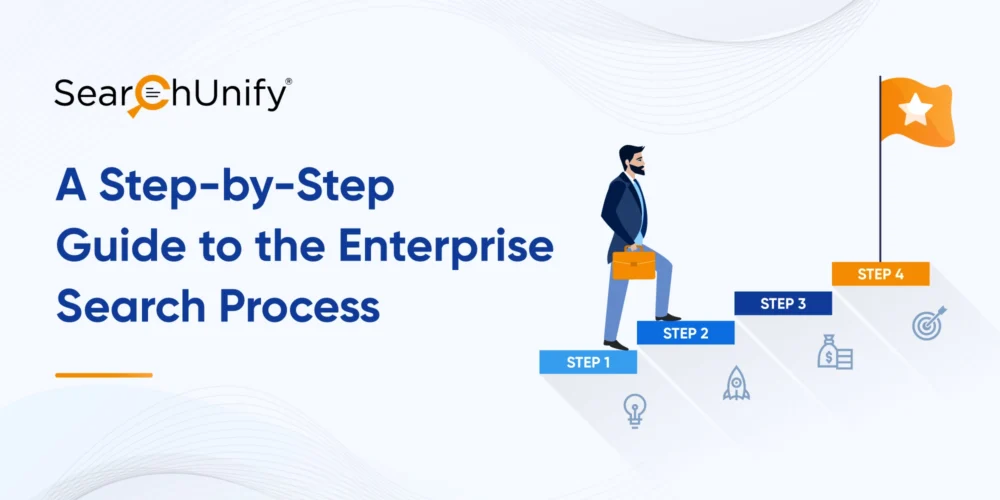
Internet search engines like DuckDuckGo and Google have become synonymous with search. And people expect similar, if not better, search experience from businesses as well. However, web and enterprise search work differently. Before we get into the enterprise search process, it important to make the distinction between web and enterprise Here’s a quick comparison between the two:
| DATA SIGNAL | WEB SEARCH | ENTERPRISE SEARCH |
| Big data | Analysis of huge data sets help with search optimization and decision-making | Data sets are rather small as compared to the web |
| Knowledge sources | There is just one source of knowledge: world wide web | Knowledge is scattered across cloud solutions, portals, servers, collaboration tools, etc. |
| Knowledge sources | Keywords (Content is optimized for specific keywords) | Prompts (High-quality prompts are created to guide LLMs to generate accurate, human-like text) |
| Data type | Most of the data is structured | Most of the data is unstructured |
| Access-control | Web is freely accessible to everyone. Though some sites require users to log in | Not everyone gets an all-access pass. Sensitive information needs to be protected |
Deciphering Enterprise Search Process
Enterprise search is a powerful solution that helps customers, employees, and partners find relevant information scattered across organization’s repositories. But how exactly does it find and deliver accurate knowledge? Let’s find out!
1. Exploration: Uncovering the Data Universe
The exploration phase sets the foundation for a successful enterprise search process. To ensure a smooth journey, let’s break down the key steps involved:
- Defined Objectives: Articulating clear objectives is essential to understand why your organization is implementing an enterprise search solution. This step involves identifying and defining the goals and objectives that the search solution aims to achieve. It is important to consider the pain points and areas of improvement within your organization that can be addressed through effective search capabilities. Additionally, defining expected outcomes helps set benchmarks for evaluating the success of the enterprise search implementation.
- Assess Data Sources: This stage considers all the data sources within your organization, including databases, file systems, content management systems, and external sources. The goal is to have a comprehensive understanding of the data landscape and the sources from which the search system will retrieve information. Prioritizing the data sources based on relevance and importance helps allocate resources and focus on the most critical data for indexing and retrieval.
- Data Profiling: Data profiling involves conducting a thorough analysis of the available data to understand its structure, format, quality, and potential challenges. The objective is to identify any inconsistencies, duplicates, missing values, or other issues that may impact the effectiveness of the search process. Profiling the data helps in cleaning and preparing it for efficient search by addressing any data quality issues and ensuring that the data is in a suitable format for indexing and retrieval.
- User Needs Analysis: Understanding the requirements and expectations of the end-users and key stakeholders is crucial for implementing a search solution that meets their needs. This analysis shapes the design and customization of the enterprise search solution to ensure that it aligns with the users’ needs and delivers a user-friendly experience.
This comprehensive phrase sets the stage for a successful enterprise search implementation, leading to improved information discovery, content retrieval, and decision-making within the organization.
2. Processing: Preparing Data for Efficient Search
This is where the data is prepared to ensure efficient search and analysis. Let’s delve deeper into the steps involved in this phase:
- Data Cleansing: While data profiling focuses on identifying inconsistencies and issues, data cleansing goes a step further by improving the quality and accuracy of search results. This is achieved by removing duplicates, correcting errors, and ensuring consistent data formats. Cleaned data enhances the precision and relevance of search operation, thus leading to more accurate and meaningful search results.
- Data Integration: Data integration is the process of bringing together data from different sources into a unified format to ensure seamless connectivity and accessibility. This step is facilitated by the use of Application Programming Interfaces (APIs) and ETL (Extract, Transform, Load) processes. APIs enable the transfer of data between different sources and the enterprise search solution, ensuring data connectivity. Connectors play a crucial role in this integration by providing pre-built interfaces to connect with various data sources. ETL processes automate tasks such as data extraction, transformation, and loading, ensuring that the data is in the appropriate format for efficient search and analysis.
- Entity Extraction: Entity extraction is a step that utilizes natural language processing (NLP) techniques to extract meaningful entities from unstructured data. These entities can include people, product or service name, organizations, locations, and other relevant information. By identifying and extracting these entities, the search system gains a deeper understanding of the search query, enabling more accurate search results.
- Language Processing: Language processing involves implementing various capabilities to effectively handle multilingual content. This includes language detection, stemming, tokenization, and more. Language detection helps determine the language of the text, enabling the search system to process and interpret it appropriately. Stemming reduces words to their base or root form, aiding in matching variations of words during the search. Tokenization breaks down text into individual words or tokens, enabling efficient indexing and retrieval. These language processing capabilities ensure that the enterprise search engine can understand the user’s needs, irrespective of the language, and deliver accurate search results in multilingual environments.
These key steps contribute to the overall success of the enterprise search process, enabling organizations to leverage the full potential of their knowledge.
3. Indexing: Organizing the Data for Quick Retrieval
Indexing is a critical step in the enterprise search process that facilitates efficient retrieval and organization of data. Here’s a more detailed explanation of its key aspects:
- Schema Design: Schema design involves creating a well-defined structure that governs the organization and properties of the indexed data. It includes defining metadata, document types, and fields to ensure accurate categorization and filtering of information. A robust schema allows for effective data organization, making it easier for the enterprise search engine to locate and retrieve specific knowledge for various user queries.
- Full-text Indexing: Full-text indexing concerns creating an index that captures the entire content of documents, enabling keyword-based searches across the enterprise. This process typically involves the extraction, tokenization, and normalization of text data. Extraction refers to extracting relevant information from documents, such as text from PDFs or HTML files. Tokenization breaks the extracted text into individual words or tokens, enabling more granular search capabilities. Normalization ensures consistency in the representation of words, considering factors like case sensitivity or diacritics.
- Security and Access Control: Implementing security measures and access controls is crucial to protect sensitive information within the indexed data. In other words, it ensures everybody cannot see everything. This involves defining user roles, permissions, and encryption protocols to ensure that only authorized individuals can access and view specific data. By implementing security and access control mechanisms, the enterprise search system ensures that sensitive information remains protected and accessible only to those with the necessary permissions.
- Incremental Indexing: Incremental indexing is the process of updating the search index in real-time to reflect changes in the underlying data sources. As new data is added, modified, or deleted, the search index needs to be updated accordingly to provide accurate and up-to-date search results. Incremental indexing minimizes the time lag between data updates and search availability, ensuring that the search results reflect the latest organizational information.
By paying attention to these essential aspects of the indexing phase, organizations can create a powerful and reliable enterprise search system. This ultimately enables users to quickly retrieve relevant information and make informed decisions based on the available data.
4. Search: Enabling Intelligent Search Capabilities
This is the stage where users interact with the enterprise search solution to find the information they need. It involves several key elements that enable intelligent search capabilities. Let’s delve deeper into each of these elements:
- Query Processing: When a user submits a search query, the system processes it to understand the user’s intent and retrieve the most relevant results. This process involves techniques such as query parsing, normalization, and semantic analysis. Query parsing breaks down the query into meaningful components, such as keywords and phrases, to extract the user’s search intent. Normalization ensures that the query and indexed content are treated consistently, accounting for variations in capitalization, plurals, and other linguistic nuances. Semantic analysis helps the system understand the context and meaning behind the query, enabling it to provide more accurate search results.
- Ranking and Relevance: Ranking algorithms play a crucial role in determining the order in which search results are presented to the user. These algorithms streamline search results based on their relevance to the query. Factors considered in the ranking process include keyword frequency (how often the query terms appear in the content), document popularity (the significance of the document based on user interactions and feedback), and other relevance indicators. By prioritizing the most relevant results, the search system improves the user experience by providing valuable information quickly and efficiently.
- Filtering and Faceting: Filters and faceted navigation empower users to further refine their search results. Filtering allows users to narrow down results based on specific criteria such as date ranges, categories, or metadata attributes. This capability is especially useful when dealing with large datasets, enabling users to focus on subsets of information that meet their specific requirements. Faceted navigation enhances the search experience by providing interactive options to explore and refine search results dynamically. Users can select different facets or attributes and observe how it affects the results, allowing them to navigate and explore the information space effectively.
- Personalization: Personalized search features tailor search results based on user preferences, historical behavior, and contextual information. By understanding user preferences and analyzing their past interactions with the search system, personalization populates more apt results. Personalization techniques consider factors such as user profiles, search history, clicked items, and demographic information to refine the search experience. This level of personalization enhances user satisfaction, increases efficiency, and enables the search system to adapt to individual users’ needs.
This process helps enterprise search solutions become more efficient, precise, and user-friendly.
Future Developments in Enterprise Search
As we conclude this step-by-step guide to the enterprise search process, we want to take a quick glance at the exciting developments and trends that will shape the future of enterprise search. These include:
- Cognitive Search: With the advancements in AI and ML, cognitive search is revolutionizing the way we interact with information. These intelligent search systems can leverage natural language processing, sentiment analysis, and ML algorithms to go beyond keyword matching to understand user intent, context, and semantics. As a result, search results will become more personalized, context-aware, and relevant, providing users with the information they need, precisely when they need it.
- Voice and Natural Language Processing: Voice-based search interfaces and conversational agents are gaining popularity in consumer applications, and this trend is expected to extend to enterprise search as well. By leveraging natural language processing (NLP) technologies, organizations can offer voice-enabled search capabilities, allowing users to interact with the search system through spoken commands or queries. Conversational search interfaces powered by AI will enable a more intuitive and efficient search experience, mimicking human-like interactions and understanding complex queries.
- Integration with Emerging Technologies: The future of enterprise search lies in its integration with other emerging technologies. We can anticipate synergies between enterprise search, chatbots, virtual assistants, and augmented reality (AR). For example, chatbots and virtual assistants can leverage enterprise search capabilities to provide real-time access to information, automate tasks, and improve employee productivity. AR technologies can overlay search results onto physical objects or environments, enabling seamless and context-aware information retrieval.
- Enhanced Analytics and Insights: As enterprise search systems evolve, they will offer advanced analytics and insight capabilities. By leveraging the processed and indexed data, organizations can gain valuable business intelligence, identify trends, patterns, and outliers, while enabling data-driven decisions. The integration of machine learning algorithms with enterprise search will further enable predictive analytics and recommendation systems, empowering organizations to stay ahead of the curve.
Conclusion
The enterprise search process is a vital component of modern information management, enabling organizations to harness the power of their knowledge for improved productivity, efficiency, and decision-making. By following the step-by-step guide and embracing future-driven trends, your organization can position itself at the forefront of enterprise search innovation.
Remember, the success of enterprise search lies in its ability to adapt to the changing needs of the digital landscape. Embrace the advancements in AI, ML, and emerging technologies, and unleash the true potential of your organization’s information assets through a robust and intelligent enterprise search solution.











